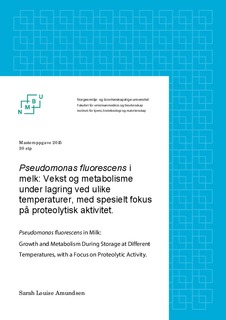| dc.description.abstract | Milk is a biological and nutritious product particularly susceptible to microbial degradation if
not handled properly. One type of psychrotrophic bacteria often associated with microbial
spoilage and impaired quality in milk and other dairy products, is Pseudomonas fluorescens.
The specie is omnipresent, has the ability to multiply at low temperatures, and many of them
may produce heat stable extracellular enzymes such as proteinases and lipases. These attack
and degrade proteins and fats respectively, which can lead to undesirable changes in milk, for
example in physical properties, appearance, taste and smell.
Trends in the dairy industry in recent years, such as efficiency and less frequent retrieval,
have resulted in prolonged cold storage of untreated milk. This means that these bacteria have
increased opportunities for growth and enzyme production, where especially the latter can
cause problems, despite pasteurization. In addition, contamination of the milk after
pasteurization can be problematic. In this study, it was desirable to investigate growth,
metabolic activity and proteolytic activity in milk during storage at three different
temperatures, by two different strains of P. fluorescens. If possible, this was supposed to be
seen in relation to the practice in the dairy industry.
In this study both the two P. fluorescens strains ATCC 13525 and ATCC 17400 showed good
growth in UHT milk, both at 4, 7 and 22 °C. The latter strain also showed strong proteolysis,
mainly of casein protein by incubation at 22 °C. The proteinases were fairly heat stable. In
milk with growth of strain B at 22 °C it was also possible to observe the biggest changes in
the content of organic acids, free amino acids and volatiles. It became evident that both
temperature and strain were important for the pattern that evolved in the milk. This points out
the importance to strive to reduce the degree of contamination and keep a low temperature,
and that good hygiene is crucial at every stage where milk is produced and processed. | nb_NO |

